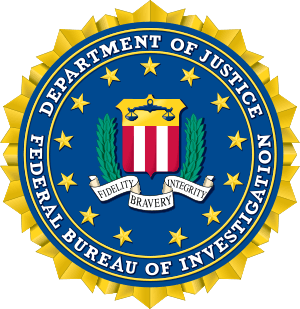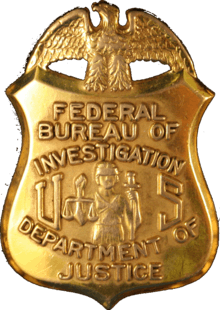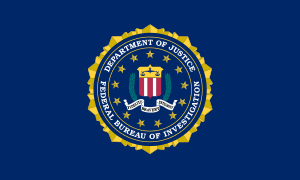Joint Terrorism Task Force
| Federal Bureau of Investigation | |||||||||||||||||||||||||||||||||||||||||||||||||||||||||||
|---|---|---|---|---|---|---|---|---|---|---|---|---|---|---|---|---|---|---|---|---|---|---|---|---|---|---|---|---|---|---|---|---|---|---|---|---|---|---|---|---|---|---|---|---|---|---|---|---|---|---|---|---|---|---|---|---|---|---|---|
| Common name | Federal Bureau of Investigation | ||||||||||||||||||||||||||||||||||||||||||||||||||||||||||
| Abbreviation | FBI | ||||||||||||||||||||||||||||||||||||||||||||||||||||||||||
|
| |||||||||||||||||||||||||||||||||||||||||||||||||||||||||||
| |||||||||||||||||||||||||||||||||||||||||||||||||||||||||||
A Joint Terrorism Task Force (JTTF) is a partnership between various local, state, and federal agencies, and private organizations that are charged with taking action against terrorism, which includes the investigation of crimes such as wire fraud and identity theft. The agencies that a JTTF comprises generally include the Federal Bureau of Investigation (FBI) and other federal agencies (the Department of Homeland Security (DHS) and its notable components such as the U.S. Coast Guard (USCG), U.S. Immigration and Customs Enforcement (ICE), U.S. Customs and Border Protection (CBP), the Transportation Security Administration (TSA), and the U.S. Secret Service (USSS), the U.S. Armed Forces, and the Department of State (DOS)'s Diplomatic Security Service (DSS)), state and local law enforcement agencies, and specialized agencies, such as railroad police.[2]
JTTFs engage in surveillance, electronic monitoring, source development and interviews in their pursuits. FBI task forces obtain written memoranda of understanding (MOUs) between participating law enforcement agencies. The FBI provides funds to pay for participating agencies' expenses, such as officer overtime, vehicles, fuel, cell phones, and related office costs.
National JTTF

The many regional JTTFs coordinate their efforts through the interagency National Joint Terrorism Task Force. NJTTF is headquartered in Washington, D.C., and is composed of representatives from 35 federal agencies.[3] The FBI's involvement with the JTTF falls under the Operational Support Branch of the FBI Counterterrorism Division.[4]
History
The first JTTF was established in 1980 in New York City, with ten FBI special agents and ten New York City Police Department (NYPD) detectives.[5] Prior to the attacks of September 11, 2001, the United States had 35 JTTFs. Shortly after the attacks, FBI Director Robert Mueller instructed all FBI field offices to establish formal terrorism task forces. There are now 100 Joint Terrorism Task Forces nationwide, including at least one at each of the FBI Field Offices, except in Portland, Oregon.
Investigations
The JTTF assisted in the investigation of the plot on Fort Dix.[6] However critics such as David Cole, a law professor at Georgetown University questioned the use of paid informants enabling aspiring terrorists. "It makes sense in general—but when you're pressing people to undertake conduct they would have never undertaken without an informant pushing them along, there is a real question if you're creating crime, not preventing crime." [7]
In the 2009 Little Rock recruiting office shooting, suspect Abdulhakim Mujahid Muhammad was warned while he was in a Yemen jail by the FBI that he would be monitored by the U.S. government, and he was investigated by the JTTF upon his return to the United States after he was deported by the Yemen government. Months after his return, he was arrested for shooting Army soldiers at a recruiting office, killing one, telling authorities after his arrest that his motive was that he was a Muslim angry about the killing of Muslims by American troops in Afghanistan and Iraq. He has since changed his plea to guilty of participating in a jihadi attack on behalf of Al-Qaeda in the Arabian Peninsula
On October 2009, Tarek Mehanna was charged in a complaint with conspiracy to provide material support to terrorists. the complaint affidavit alleges that Mehanna and coconspirators discussed their desire to participate in violent jihad against American interests and that they would talk about fighting jihad and their desire to die on the battlefield. The case was investigated by the FBI’s Joint Terrorism Task Force (JTTF) members: U.S. Immigration and Customs Enforcement, U.S. Customs and Border Protection, the Massachusetts State Police, and the Lowell Police Department, in addition to other members.[8]
In the Fort Hood shooting, suspect Nidal Malik Hasan was first brought to the attention of the FBI by internet postings which justified suicide bombings as military operations, but they were not judged to be a threat. Then in December 2008, the National Security Agency intercepted communications from an Army officer with a suspected terrorist, Anwar al-Awlaki. After examination by a JTTF, the e-mails which asked if Islam permitted the killing of soldiers who were to be sent to combat against Muslims, and how to send money to support Awlaki's causes could be sent without reporting to the government were judged to be consistent with research he had presented in a presentation which had warned of "adverse events" if Muslims were forced to fight other Muslims.[9]
The FBI was also notified of large amounts of money that Hasan had wired to charities in Pakistan, but the FBI determined that the money "went to people not related to terrorism,"[10] On November 9, 2009, the FBI said that investigators believed Hasan had apparently acted alone. They disclosed that they had reviewed evidence which included the 2008 e-mail conversations but said they did not find any evidence that Hasan had direct help or outside orders in the shootings.[11] According to a November 11 press release, after preliminary examination of Hasan's computers and internet activity, they had found no information to indicate he had any co-conspirators or was part of a broader terrorist plot "at this point".[12] Although this was what they stressed were the "early stages" of the review, no contrary conclusions had been reached even after reports that the US government believed that Awlaki had been the target of airstrikes in Yemen, and that on December 26, 2009, investigators said that the suspect of the Northwest Airlines Flight 253 bombing admitted that he had attended camps in Yemen where al-Qaeda members including Anwar al-Awlaki had instructed him, blessed the attack, and provided the bomb.
On the morning of September 24, 2010, several homes of people active in campaigns against U.S. military intervention and Palestine and Columbia Solidarity were raided by FBI agents part of JTTFs. Four houses in Minneapolis were raided (including people involved with the 2008 Republican National Convention protests in Saint Paul), along with houses in Michigan, North Carolina, and Chicago. The search warrants focused on obtaining information from computers and other sources of alleged "facilitation of other individuals in the United States to travel to Colombia, Palestine and any other foreign location in support of foreign terrorist organizations including but not limited to FARC, PFLP and Hezbollah." No arrests were made, but agents subpoenaed activists to testify before a grand jury in Chicago in October, with reference to "material aid to terrorist organizations."[13][14]
Criticism
According to the ACLU, documents obtained through the Freedom of Information Act indicate that officers from the Colorado JTTF collected personal information on what the FBI termed "criminal extremists" but that the ACLU maintained were "peaceful protesters who have no connection to terrorism or any other criminal activity."[15][16]
A detective with the Fresno County Sheriff's Department and member of the JTTF, attended public meetings of Peace Fresno in 2003. The Sheriff's Department issued the following statement, "For the purpose of detecting or preventing terrorist activities, the Fresno County Sheriff’s Department may visit any place and attend any event that is open to the public, on the same terms and conditions as members of the public generally."[17]
On April 28, 2005, Portland became the only city in the nation to withdraw from a JTTF.[18][19] As of February 19, 2015, the Portland city council approved permanently staffing the JTTF with two of its city's police officers.[20]
In June 2008, according to City Pages the JTTF based in Minneapolis approached a source to infiltrate vegan potlucks and eventually report back to authorities on organized protesting activities in preparation for the 2008 Republican National Convention in nearby Saint Paul.[21]
In the wake of the FBI's consistent performance in handling red flags of possible terrorist threats after the 2009 Fort Hood shooting case, Clarice Feldman of American Thinker asked "Aside from racing to the scene of the massacre and declaring that this was not an act of terrorism, what is the FBI's role in counter-intelligence? Isn't it time we stripped them of a task they regularly perform so poorly?"[22] The New York Post headline stated "FBI blew off killer e-mail to al Qaeda Officials admit shrugging off gunman's e-mails to Qaeda".[23] The article wrote "The clueless G-men said that at the time, they simply chalked up the chilling e-mails between Hasan and a radical imam and other terror-tied Islamic figures to his 'research' as an Army shrink... red-faced agency vowed to get to the bottom of things itself."
References
- 1 2 3 "Frequently Asked Questions". Federal Bureau of Investigation. Retrieved 2016-09-02.
- ↑ Feldstein, Dan (June 27, 2004). "Identity thieves stealing attention / Horror stories help crime gain notoriety". Houston Chronicle.
- ↑ "FBI Congressional Testimony". FBI. September 4, 2003.
- ↑ "Counterterroism Division Organizational Chart". Office of the Inspector General. December 2003.
- ↑ "Protecting America Against Terrorist Attack – A Closer Look at the FBI's Joint Terrorism Task Forces". FBI. December 1, 2004.
- ↑ Archived May 31, 2010, at the Wayback Machine.
- ↑ Rolling Stone | Political News, Matt Taibbi, Politics, Issues and More Archived April 14, 2009, at the Wayback Machine.
- ↑ "Federal Bureau of Investigation – The Boston Division: Department of Justice Press Release". Boston.fbi.gov. 2009-10-21. Retrieved 2012-01-14.
- ↑ Shane, Scott and Dao, James; Tangle of Clues About Suspect at Fort Hood, New York Times, November 14, 2009, retrieved November 14, 2009.
- ↑ Memmott, Mark (2009-11-24). "Report: Hasan's Money Transfers To Pakistan Not Tied To Terrorism : The Two-Way". NPR. Retrieved 2012-01-14.
- ↑ "Investigators say Fort Hood suspect acted alone". Associated Press. November 9, 2009."a separate investigation revealed Hasan's communications with another individual they declined to identify. Separately, another U.S. official said the person Hasan was communicating with was Anwar al-Awlaki"
- ↑ "Investigation Continues Into Fort Hood Shooting". FBI. November 11, 2009. Archived from the original on November 17, 2009. Retrieved November 12, 2009.
- ↑ "At least four houses in Minneapolis raided, other houses in Michigan, NC, Chicago targeted Twin Cities". IndyMedia. 2010-09-24.
- ↑ "Protest FBI raids of homes of peace activists". Keep Left US blog. 2010-09-27.
- ↑ "Press Release from ACLU of Colorado". ACLU. December 8, 2005.
- ↑ "Are things any different in Denver?". Center for Public Integrity. Retrieved 2015-09-07.
- ↑ "Peace Group Infiltrated by Government Agent". Democracy Now!. October 9, 2003.
- ↑ "FBI's Joint Terrorism Task Force". ACLU Oregon. April 28, 2005.
- ↑ Byron York (Nov 28, 2010). "Politically correct Portland rejected feds who saved city from terrorist attack". Washington Examiner.
- ↑ "After 10-year hiatus, Portland OKs cops for FBI's Joint Terrorism Task Force". Retrieved 2015-09-07.
- ↑ Matt Snyder (June 3, 2008). "Whack a Mole". City Pages.
- ↑ Feldman, Clarice (2011-07-28). "The FBI in peace and war". American Thinker. Retrieved 2012-01-14.
- ↑ Doyle, John (November 10, 2009). "FBI blew off killer e-mail to Al Qaeda Officials admit shrugging off gunman's e-mails to Qaeda". New York Post.
External links
- The Joint Terrorism Task Force: A Concept That Works
- Joint Terrorism Task Force (JTTF)
- UT-Austin Joint Terrorism Task Force (JTTF)
- Managing Joint Terrorism Task Force Resources
- Center for Media & Democracy's Joint Terrorism Task Force Information Page
- Deflem, Mathieu. 2012. "Joint Terrorism Task Forces." pp. 423–426 in Counterterrorism: From the Cold War to the War on Terror, Vol. 1, edited by Frank G. Shanty. Santa Barbara, CA: Praeger/ABC-CLIO.


